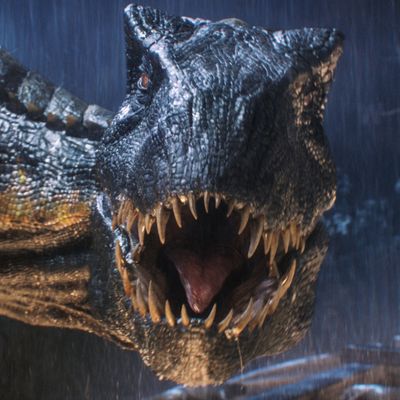
The Jurassic World movies don’t exactly prize plausibility. Would financiers be able to open a park full of dinosaurs after three previous movies resulted in dozens of dino-related fatalities? Is it possible to run in heels all day without incurring some monstrous blisters? And would dinosaurs really go to so much trouble to stalk and eat hiding humans, who seem like awfully measly morsels compares to some of the other nearby beasts they could be devouring? (If an M&M rolls underneath my couch, I’m not going to thrust my thrashing face down there in a desperate bid to reclaim it. That M&M will remain on the floor until the day my lazy ass sells this house.)
Still, even though we know that things will be exaggerated for the purpose of moviemaking, it’s still a thrill to watch these prehistoric animals do their thing. It’s impossible now to think of a T. rex, a velociraptor, or a stegosaurus without also thinking of their Jurassic scenes, our memories of this franchise commingling with what we once read about these animals in textbooks. Somewhere, amid all the action scenes and the derring-do, you can cobble together an idea of what those dinosaurs must have really been like, and it’s thrilling to get that glimpse into life on earth 65 million years ago.
So why are the new Jurassic World movies determined to reject all that history and invent dinosaurs that never existed?
In the first new installment of this franchise, released in 2015, theme-park engineers decide to goose attendance by designing a fictional dinosaur called the Indominus rex. I understand that director Colin Trevorrow wanted to up the ante from Steven Spielberg’s original Jurassic Park by creating a beast that is bigger, bolder, and badder than even the T. rex, but without the frisson of seeing a real dinosaur revived, the movie ended up with something forgettable. If you asked me to recall what the Indominus rex looked like, I couldn’t even give you a distinguishing feature.
It happens again in Jurassic World: Fallen Kingdom, out this weekend. For much of the movie, we keep hearing about a particularly fearsome beast hidden in a basement laboratory, and one might wonder whether we’re going to see a dinosaur that the franchise hasn’t yet given a spotlight to, something that might send you rushing to Wikipedia when the movie is over. Hell, maybe they even brought back a different prehistoric animal, like the saber-tooth cat! Wouldn’t you love to see a Smilodon thrown into the mix with all those rampaging dinosaurs?
And yet, it’s just another knockoff. The hidden monster is the “Indoraptor,” a modified version of the velociraptor that has been given a hodgepodge of malevolent traits from the T. rex and other dinosaurs. In other words, it’s a muddle.
There are over 700 species of dinosaurs to choose from, but the Jurassic World filmmakers keep picking over the same old fossils. Instead of creating beasts that feel like a Xerox of a Xerox, why not exhume a different dinosaur? The velociraptor and spitting dilophosaurus were hardly household names before the first Jurassic Park made them iconic, and this series would do well to keep finding those real creatures to resurrect. At the very least, maybe the franchise should take one of its own lessons to heart: It’s folly to regard Mother Nature and think that you could outdo her.

